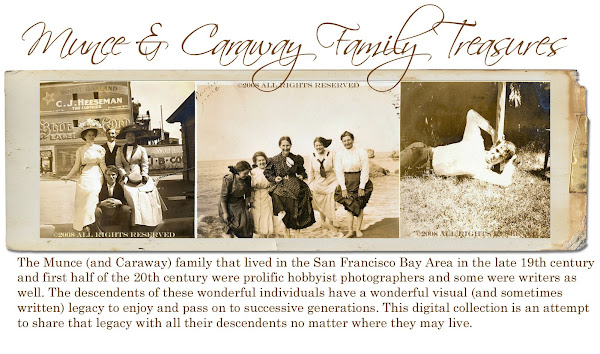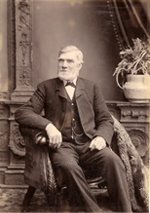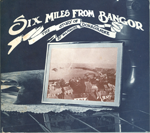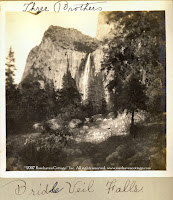Many in the world today unite their voices in speaking about making our world a healthier and more beautiful place to live by being environmentally aware.
I have an interesting perspective about this issue, one that I've come to realize is quite unique. I hope that by sharing it, I can somehow make a small difference.
One does not have to win a Nobel Peace Prize, make a film, donate thousands upon millions of dollars, or become a chest-thumping activist to make a difference in this world as far as the environment is concerned. One simply has to be a good steward over that which one has been given and pass that legacy of awareness and good stewardship on to the next generation in one way or another. It's that simple. How do I know? Because I am a product of it!

Let me introduce you to a couple of true environmentalists--my great-grandparents, William and Elsie. They are pictured here riding mules during a long summer vacation in Yosemite National Park in 1912.

They traveled to Yosemite via covered wagon from their home in Oakland, California. By car on today's modern roads it is a 3-4 hour trip, so you can imagine how long it took in a covered wagon!
William ("Bill") and Elsie ("El") were simple city folk. They didn't have a lot of money. Bill was a metalworker and would have been considered "blue collar" nowadays. El was a homemaker who was active in her community organizations. They were also nature-lovers. They loved the outdoors and took time for daytrips to enjoy the many beautiful outdoor areas around their local San Francisco Bay Area. During summers, they would enjoy longer vacations that were simple and inexpensive like trips to Yosemite.
Bill was an avid gardener and amateur horticulturist grafting fruit trees, growing roses, and maintaining a produce garden on his urban lot in Oakland. El had been raised by gardening parents, so she had a connection to gardens as well. Together they made room for gardens and a chicken coop on their city lot. Bill and El's three children (Little Elsie, Jack, and Fred) grew up with gardens being a part of their upbringing.




Top: Bill holding his oldest, Little Elsie (Grammy) out in his garden (note the chicken coop behind him).
Second from top: Elsie (Grammy) and Jackie out in the family garden.
Third from top: Jackie out in the flower garden (note how close their neighbors are and also note that they don't have the traditional lawn).
Bottom: Fred helping in the garden with a watering can almost too big to lift.
 Once they had children, Bill and El continued to take daytrips around the Bay Area to enjoy nature. And they also took their children on longer vacations to national parks throughout the state of California, including Yosemite. Camping and visiting national parks was an inexpensive way to have a family vacation. It was also a great way to get away from the city and enjoy the beauties of nature. No longer needing to take a covered wagon, they took the family automobile on these excursions. Although not recommended by any means, Bill went so far as to feed the bears at Yosemite to have a "close up" nature encounter (pictured at left).
Once they had children, Bill and El continued to take daytrips around the Bay Area to enjoy nature. And they also took their children on longer vacations to national parks throughout the state of California, including Yosemite. Camping and visiting national parks was an inexpensive way to have a family vacation. It was also a great way to get away from the city and enjoy the beauties of nature. No longer needing to take a covered wagon, they took the family automobile on these excursions. Although not recommended by any means, Bill went so far as to feed the bears at Yosemite to have a "close up" nature encounter (pictured at left).
This love of nature and gardening was easily and very naturally passed on to Grammy (Elsie Louise). Subsequently, Grammy passed that love of nature as well as a sense of stewardship over earth's many beauties to her three daughters (Ann, Sue and Joanie).
As a conservative suburban housewife in the 1960's, I know that Sue started early passing on those values and understandings to her own children. I was her first, so my early experiences are probably more well-documented photographically, but all three of us got the choice experience of being raised by a mom who was always gently telling us about those things in nature that we were surrounded by every day. My mom would matter-of-factly indentify trees, plants, and flowers for us and then shared some special childhood memory connected to them if there was one. And she would teach us "tricks" on how to identify them.
My mom took advantage of opportunities to take us to local petting zoos, natural history museums, and parks, so we could have firsthand experience with animals. These experiences helped us gain an understanding and love for animals which is an essential part of the foundation of an environmentally-conscious adult. My mother also did other unorthodox things. For instance, she knew I was fascinated with horses so sometimes after mowing the lawn she took me to feed the lawn clippings (and some carrots she brought along) to some horses at a nearby field. As opportunities arose, she would gently share her knowledge of how everything in nature is interdependent. We learned the "circle of life" long before it was ever portrayed in an animated motion picture. On family vacations to Disneyland, she would slip into the itinerary stops at the California Missions so we could see a bit of history and tour the gardens or visit the working farms that still existed. We aren't Catholic. This was just my mom's way of educating us about the environment in a stealthy but effective way.




Top: Me at about age 3 or 4 out on a nature outing in the wintertime.
Second from top: Me at age 2 at the Oakland Zoo hugging a goat.
Third from topt: Me feeding some horses our lawn clippings. My mom drove me and the clippings there, because she knew I loved horses.
Bottom: My sister and me out in nature in the wintertime.
My mom also had books about nature, gardening, and animals present in our family library. Whenever we wanted, we could pull a book off the shelf and browse. She was available to answer questions, but for the most part the journey of discovery in those books was a private one for each of us. Interestingly, one of my favorites when I was 5 or 6 years old was an Audubon Society guide to North American birds. As I became a more advanced reader there were books available to me such as the James Herriot All Creatures Great and Small series. I was welcome to take them and read them at my leisure. I ended up reading the entire James Herriot series over the course of a year on the school bus on the way to high school when I was a freshman. Those books gave me an understanding of man's relationship to animals that still impacts me today.
As an adult, all those understandings and values about the environment were part of me. The fibers are so intertwined with who I am, there is no question that I care about the environment and want to make a difference. I had learned through example that the best way to make a difference was to start with what I had control over--my own home.
In our first apartment as newlyweds, I planted tomatoes and flowers in pots on our front stoop and in the little narrow strips of dirt around our miniscule patio. Later when we moved to Rosehaven Cottage, the potted Red Japanese Honeysuckle (a favorite of bees and hummingbirds) and white "Princess Diana" Bower Vine that were on that front stoop became a part of the Rosehaven Cottage garden and are still here today growing madly up the front pergola.
Rosehaven Cottage's gardens were a blank canvas. The lot isn't terribly large, but I saw in it the potential to become the gardens I had always wanted. Rosehaven Cottage sits in an interesting geographical location of being somewhat rural but just within sight of an oil refinery's stacks. So there is an odd combination of industry and nature happening all at the same time.
I scoured the internet for resources on how to plant a garden that would be friendly to the animals and insects that already lived here and provide them with a home in the midst of industry. Through the help of my mother (again giving me gentle guidance), I found the National Wildlife Federation's website on how to build your own backyard wildlife habitat. I used their guidelines and eventually certified the Rosehaven Cottage gardens with their national registry.
Now I chronicle my experiences with my garden and backyard wildlife habitat here at my blog.
The Bottomline
The best, most effective, and easiest way to make a difference in this world is to start at home.
Educate yourself about what surrounds you. Learn why bees and other insects need water sources that you can easily provide for them in any setting. Learn what frog is keeping you up at night with its incessant ribbet-ribbet-ribbet. Learn how to use the hundred-year-old method of companion planting instead of using pesticides in your garden. Learn why it is better to let your flowers go to seed and not always have a perfectly coifed garden.
Learn, learn, learn! We've got an amazing tool available to us--the internet! So, why not use it?
Then implement what you've learned in your own living situation. As Bill and El proved, you don't have to live on a farm or be financially well-off to do it. A few potted plants on a fire escape makes a difference.
And once you've learned and begun to implement what you've learned into your own living sitation then gently pass that knowledge and experience on to the next generation through example.
It's as simple as that.






























































